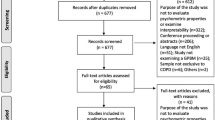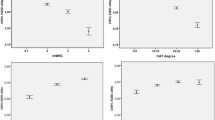Abstract
The objective of the study was to evaluate the reliability, validity and responsiveness of two generic multiattribute methods for measuring utility for health states: a 15-dimensional (15D) and a five-dimensional method (EuroQol and EQ-TTO). A self-administered questionnaire with both measures was used in 59 outpatients with chronic obstructive pulmonary disease and the findings compared with standard gamble (SG) and time trade-off (TTO) utilities, spirometry and arterial blood gases. Quality of life scores were smallest for EQ-TTO (median 0.73) and highest for SG and TTO (median 0.91 and 0.95 respectively), while 15D gave intermediate values (median 0.80). The test retest reliability over 14 days was: 15D (r=0.90) and EQ-TTO (r=0.73), using Spearman's rank correlation. 15D was better than EQ-TTO at discriminating between groups of patients after reported global rating of change over 12 months (P=0.004 versus P=0.09), indicating that 15D was more responsive. The 15D instrument has many attractive properties when compared to the EQ-TTO method, including a better reliability and responsiveness. Validity depends on validation method. The findings in this study indicate that the different utility measures measure different aspects of health-related quality of life (HRQoL). Caution should be taken when choosing utility instruments in cost-utility studies, as this can strongly influence the results.
Similar content being viewed by others
References
Weinstein MC, Stason WB. Foundations of costeffectiveness analysis for health and medical practices. N Engl J Med 1977; 298: 716–721.
Torrance GW. Measurement of health state utilities for economic appraisal. J Health Econ 1986; 5: 1–30.
Froberg DG, Kane RL. Methodology for measuring health-state preferences–I: measurement strategies. J Clin Epidemiol 1989; 42: 345–354.
Guyatt GH, Berman LB, Townsend M, Pugsley SO, Chambers LW. A measure of quality of life for clinical trials in chronic lung disease. Thorax 1987; 47: 76–83.
Hyland ME, Finnis S, Irvine SH. A scale for assessing quality of life in adult asthma sufferers. J Psychosom Res 1991; 35: 99–110.
Jones PW, Quirk FH, Baveystock CM, Littlejohns P. A self-complete measure of health status for chronic airflow limitation: the St George's respiratory questionnaire. Am Rev Respir Dis 1992; 145: 1321–1327.
Juniper EF, Guyatt GH, Epstein RS, Ferrie PJ, Jaeschke R, Hiller TK. Evaluation of impairment of health related quality of life in asthma: development of a questionnaire for use in clinical trials. Thorax 1992; 47: 76–83.
Marks GB, Dunn SM, Woolcock AJ. A scale for the measurement of quality of life in adults with asthma. J Clin Epidemiol 1992; 45: 461–472.
McSweeny AJ, Grant I, Heaton RK, Adams KM, Timms RM. Life quality of patients with chronic obstructive pulmonary disease. Arch Intern Med 1982; 142: 473–478.
Kaplan RM, Atkins CJ, Timms R. Validity of a quality of well-being scale as an outcome measure in chronic obstructive pulmonary disease. J Chronic Dis 1984; 37: 85–95.
Prigatano GP, Wright EC, Levin D. Quality of life and its predictors in patients with mild hypoxemia and chronic obstructive pulmonary disease. Arch Intern Med 1984; 144: 1613–1619.
Jones PW, Baveystock CM, Littlejohns P. Relationships between general health measured with the Sickness Impact Profile and respiratory symptoms, physiologic measures and mood in patients with chronic airflow limitation. Am Rev Respir Dis 1989; 140: 1538–1543.
Mahler DA, Mackowiak J. Evaluation of the Short-Form 36-item questionnaire to measure health-related quality of life in patients with COPD. Chest 1995; 107: 1585–1589.
Viramontes JL, O'Brien B. Relationship between symptoms and health-related quality of life in chronic lung disease. J Gen Intern Med 1994; 9: 46–48.
Von Neumann J, Morgenstern D. The Theory of Games and Economic Behavior, 3rd edn. New York: John Wiley, 1953.
Torrance GW, Sackett DL, Thomas WH. A utility maximization model for program evaluation of health care programmes. Health Serv Res 1972; 7: 118–133.
Revicki DA, Kaplan RM. Relationship between psychometric and utility-based approaches to the measurement of health-related quality of life. Qual Life Res 1993; 2: 477–487.
Nord E. Methods for quality adjustment of life years. Soc Sci Med 1992; 34: 559–569.
Froberg DG, Kane RL. Methodology for measuring health state preferences – III: population and context effects. J Clin Epidemiol1989; 42: 585–592. 99 53</del>
Nord E. Health status index models for use in resource allocation decisions: a critical review in the light of observed preferences for social choice. Int J Technol Assess Health Care 1996; 12: 31–44
Feeny D, Furlong W, Boyle M, Torrance GW. Multiattribute health status classifications systems. Health utilities index. PharmacoEconomics 1995; 7: 490–502.
Epstein AM, Hall JA, Tognetti J, Son LH, Conant L Jr. Using proxies to evaluate quality of life. Med Care 1989;27: S91–S98.
EuroQol© Group. EuroQol©: a new facility for the measurement of health related quality of life. Health Policy 1990; 16: 199–208.
Sintonen H, Pekurinen M. Afifteen-dimensional measure of health-related quality of life (15D) and its applications. In: Walker SR, Rosser R, eds. Quality of Life Assessment.Key Issues in the 1990s. Dordrecht: Kluwer Academic Publishers, 1993: 185–195.
Dolan P, Gudex C, Kind P, Williams A. A Social Tariff for EuroQol:Results from a UK General Population Study. York: University of York, Centre for Health Economics, 1995.
Sintonen H. The 15D-measure of Health-related Quality of Life.I.Reliability, Validity and Sensitivity of its Health State Descriptive System. Melbourne: National Centre for Health Program Evaluation, 1994.
Sintonen H. The 15D-measure of Health-related Quality of Life.II.Feasibility, Reliability and Validity of its Valuation System. Melbourne: National Centre for Health Program Evaluation, 1994.
Froberg DG, Kane RL. Methodology for measuring health-state preferences – II: scaling methods. J Clin Epidemiol 1989; 42: 459–471.
Kaplan RM, Feeny D, Revicki DA. Methods for assessing relative importance in preference based outcome measures. Qual Life Res 1993; 2: 467–475.
Marks GB, Dunn SM, Woolcock AJ. An evaluation of an asthma quality of life questionnaire as a measure of change in adults with asthma. J Clin Epidemiol 1993; 46: 1103–1111.
Perpiñá M, Belloch A, Pascual LM, de Diego A, Compte L. Quality of life and asthma. Validation of the AQLQ questionnaire for use in Spain. Arch Bronconeumol 1995; 31: 211–218 (in Spanish).
Ware JE Jr, Snow KK, Kosinski M, Gandek B. SF-36 Health Survey.Manual and Interpretation Guide. Boston, MA: The Health Institute, New England Medical Center, 1993.
McHorney CA, Ware JE Jr, Lu JFR, Sherbourne CD. The MOS 36-item short-form health survey (SF-36): III. Tests of data quality, scaling assumptions and reliability across diverse patient groups. Med Care 1994; 32: 40–46.
Aaronson NK, Acquadro C, Alonso J, et al. International quality of life assessment (IQOLA) project. Qual Life Res 1992; 1: 349–351.
Karnofsky DA, Burchenal JH. The clinical evaluation of chemotherapeutic agents in cancer. In: Macleod CM, ed. Evaluation of Chemotherapeutic Agents. New York: Columbia University Press, 1948.
Medical Research Council: Questionnaire on Respiratory Symptoms. London: Medical Research Council, 1986.
McGavin CR, Artvinli M, Naoe H, McHardy GJR. Dyspnoea, disability and distance walked: a comparison of estimates of exercise performance in respiratory disease. BMJ 1978; 2: 241–243.
Quanjer PH, ed. Standardized lung function testing. Report of Working Party for Standardization of Lung Function Tests. European Community for Coal and Steel, Luxembourg. Bull Eur Physiopathol Respirat 1983; 19 (suppl 5): 1–95.
Borg G. Perceived exertion as an indicator of somatic stress. Scand J Rehab Med 1970; 2–3: 92–98.
Altman DG, Bland JM. Measurement in medicine: the analysis of method comparison studies. Statistician 1983; 32: 307–317.
Bland JM, Altman DG. Statistical methods for assessing agreement between two methods of clinical measurement. Lancet 1986; 1: 307–310.
Deyo RA, Diehr P, Patrick DL. Reproducibility and responsiveness of health status measures. Control Clin Trials 1991; 12: 142S–148S.
Hays RD, Anderson R, Revicki DA. Psychometric evaluation and interpretation of health-related quality of life data. In: Shumaker SA, Berzon R, eds. The International Assessment of Health-related Quality of Life: Theory, Translation, Measurement and Analysis. Oxford: Rapid Communications, 1995: 103–114.
Guyatt G, Walter S, Norman G. Measuring change over time: assessing the usefulness of evaluative instruments. J Chronic Dis 1987; 40: 171–178.
Bombardier C, Wolfson AD, Sinclair AJ, McGeer A. Comparison of three preference measurement methodologies in the evaluation of a functional status index. In: Deber RR, Thompson GG, eds. Choices in Health Care.Decision Making and Evaluation of Effectiveness. Toronto: Department of Health Administration, University of Toronto, 1982: 145–159.
Stavem K. Quality of life in epilepsy: comparison of four preference measures. Epilepsy Res 1998; 29:201–209.
Lalonde L, Clarke AE, Grover SA. Comparing a health status instrument with conventional utility instruments. Qual Life Res 1995; 4: 451 (abstract).
Rutten-van Mölken MPMH, Custers F, van Doorslaer EKA et al. Comparison of performance of four instruments in evaluating the effects of salmeterol on asthma quality of life. Eur Respir J 1995; 8: 888–898.
Torrance GW, Boyle MH, Horwood SP. Application of multi-attribute utility theory to measure social preferences for health states. Operat Res1982; 30: 1043–1069.
Revicki DA. Relationship between health utility and psychometric health status measures. Med Care 1992; 30: MS274–MS282.
Tsevat J, Goldman L, Lamas GA et al.Functional status versus utilities in survivors of myocardial infarction. Med Care 1991; 29: 1153–1159.
Brooks RG, Jendteg S, Lindgren B, Persson U, Björk S. EuroQol: health related quality of life measurement. Results of the Swedish questionnaire exercise. Health Policy 1991; 18: 37–48.
Nord E. EuroQol: health related quality of life measurement. Valuations of health states by the general public in Norway. Health Policy 1991; 18: 25–36.
Author information
Authors and Affiliations
Rights and permissions
About this article
Cite this article
Stavem, K. Reliability, validity and responsiveness of two multiattribute utility measures in patients with chronic obstructive pulmonary disease. Qual Life Res 8, 45–54 (1999). https://doi.org/10.1023/A:1026475531996
Issue Date:
DOI: https://doi.org/10.1023/A:1026475531996




